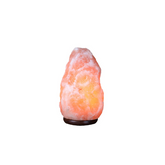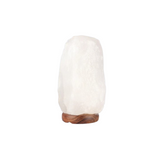Coarse vs. Fine Himalayan Salt: When to Use Each
Coarse vs. Fine Himalayan Salt: When to Use Each
Choosing between coarse salt and fine salt isn’t just a matter of texture it affects how salt dissolves, seasons, and presents in your dishes. With Himalayan salt, those differences become more pronounced thanks to its natural minerals and crystal structure. This guide helps you understand uses, benefits, and practical tips for choosing coarse or fine Himalayan salt. Whether you're seasoning, cooking, finishing, or gifting, knowing when to use each can elevate your recipes and flavor.
Understanding Coarse and Fine Himalayan Salt
| Feature | Coarse Himalayan Salt | Fine Himalayan Salt |
|---|---|---|
| Crystal Size | Large grains, visible flakes or shards | Powdered or small uniform grains |
| Dissolution Speed | Slower ideal for salt rubs, finishing, or salt blocks | Fast ideal for baking, seasoning, and soups |
| Saltiness Per Volume | Less salty by volume (per teaspoon) due to lower density | Stronger flavor when measured by volume |
| Texture & Mouthfeel | Crunchy, decorative, bursts of salt | Smooth, blends evenly without texture |
When to Use Coarse Himalayan Salt
Coarse salt shines in scenarios where texture, slow release, or visual appeal matter:
- Finishing Dishes: A sprinkle of coarse salt flakes over chocolate, grilled steak, or desserts adds a crunchy, salty burst.
- Salt Blocks & Grilling: Cooking on heated salt slabs benefits from large crystals that hold structure under high heat.
- Salt Rubs & Marinades: Coarse salt mixed into rubs gives time to draw moisture before cooking.
- Salt Crust Roast: Enveloping meat in coarse pink salt traps flavor and helps with crust formation.
When to Use Fine Himalayan Salt
Fine salt works best when you need quick dissolving, even seasoning, or precise control:
- Baking & Doughs: Uniform texture and predictability great for breads, cookies, or pastry where salt incorporation matters.
- Soups, Sauces, and Stocks: Fine grains dissolve quickly, distributing flavor evenly.
- Everyday Seasoning: For stir-fries, stews, salad dressings, and where control over saltiness is essential.
- Salted Beverages/Sole Water: If making pink-salt water tonics or adding salt to drinks, fine salt avoids grainy texture.
How to Measure & Substitute
Because coarse salt and fine salt differ in crystal size, a teaspoon of each delivers different saltiness:
- Substitution tip: If a recipe calls for 1 teaspoon fine Himalayan salt, use about ½–⅔ teaspoon coarse to match flavor (depending on crystal chunk size).
- Always weigh salt when precise results matter (especially in baking or pickling) they offer consistency.
Product Use & Shop Recommendations
When purchasing Himalayan salt, consider options in both textures. If you're shopping for cooking or finishing, look for these:
- Coarse Himalayan salt flakes – great for finishing and salt blocks.
- Fine Himalayan pink salt – ideal for baking and general seasoning.
Check product descriptions for “coarse salt” or “fine grains” to ensure texture matches intended use.
Texture vs. Flavor: How Minerals Play a Role
Himalayan salt contains trace elements like iron, magnesium, and calcium that subtly influence flavor and mouthfeel. While these minerals do not drastically change saltiness, they provide:
- A slight earthy or mineral undertone
- Variation in color and sparkle
- Slight texture differences fine salt gives a soft feel; coarse salt adds crunch
Practical Comparison Table: Coarse vs. Fine Uses
| Application | Use Coarse When… | Use Fine When… |
|---|---|---|
| Baking | Using coarse salt for decorative toppings | Measuring salt into batter |
| Finishing desserts | Want crunch & visual contrast | Need uniform salt distribution |
| Stock or soup boiling | Coarse salt may leave residue or dissolve slowly | Fine salt dissolves cleanly |
| Salt block grilling | Coarse salt under high heat | Fine salt may burn or become gritty |
Common Myths About Coarse vs. Fine Himalayan Salt
-
Myth: Coarse salt is “healthier” because it’s larger crystals.
Truth: The health difference is negligible; it’s the sodium content that matters. -
Myth: Fine salt is more processed.
Truth: Both coarse and fine Himalayan salt originate from the same source; the difference lies only in grinding and sieving.
Best Practices in the Kitchen
- Keep both textures on hand coarse for finishing, fine for cooking.
- Store coarse salt in a dry, airtight container to prevent moisture from clumping crystals.
- Use fine salt sparingly to avoid over-salting. Taste as you go.
- Use coarse flakes for visual appeal sprinkle at the end rather than stirring in.
Relationship to Other Himalayan Salt Uses
Choosing coarse vs. fine ties into broader topics in the Himalayan salt recipes cluster from baking to seasoning to wellness. It also links to product options for edible salts, or to guides on storage and salt type comparisons.
Final Thoughts
Coarse Himalayan salt adds texture, visual drama, and slow-dissolving power perfect for finishing, grilling, or dramatic presentation. Fine Himalayan salt offers smooth, even seasoning and precise control ideal for baking, sauces, and everyday cooking. Knowing which to use when will elevate your dishes and help you get the most out of the pink salt’s unique profile.





